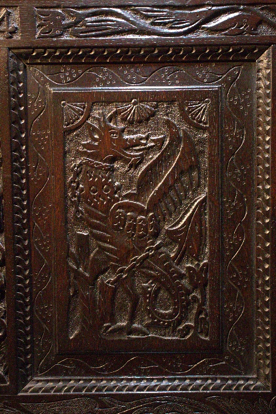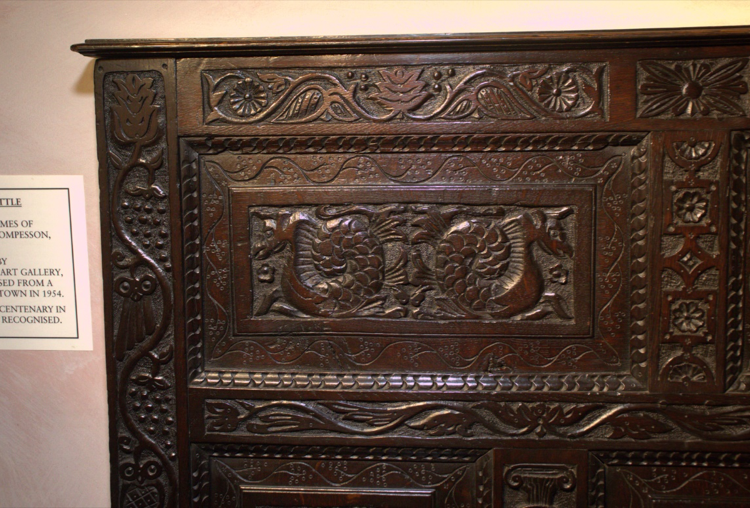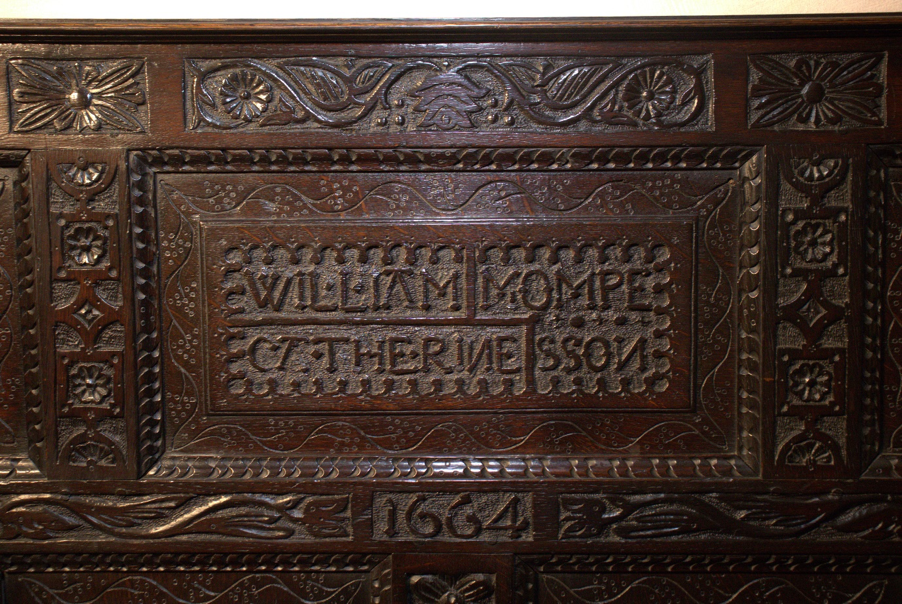The Carvings of the Mompesson Settle
by Wesley Leak, BA2 Conservation of Cultural Heritage
In June 2022 after completing my second-year studies of BA Conservation of Cultural Heritage, I began a research project through UROS to understand the 1664 Mompesson Settle at the Eyam Museum, Derbyshire. The Undergraduate Research Opportunities Scheme (UROS) is designed to encourage undergraduate students to take part in research work of the university. I took this project on over the summer to help me gain experience in a sector of conservation that I would otherwise not cover in as much detail.
The aims of this project are to identify the age of the settle, identify the meanings of the carved symbols and improve visitor understanding. This project is still ongoing but, in this blog, I will talk about the research I’ve been doing so far, to understand the carvings and their potential meanings.
Background Information
The settle is situated in the Eyam Museum and has the names of William and Catherine Mompesson with the date 1664 carved, this was the year that they moved to Eyam. William Mompesson was the rector at Eyam when the plague reached the village in 1665, he and former rector Thomas Stanley organised the village to isolate to stop the disease spreading in the local area, which makes the village famous today. Catherine, Williams’ wife died of the plague along with 260 other villagers from September 1665 to November 1666.
The first step of my research was to visit Eyam Museum to see the settle and take a detailed look at it supervised by Lynda Skipper and Henning Schulze (fig.1). We documented it with photographs and measurements. Henning, the wood expert at the university, identified manufacturing marks and techniques on the settle. We initially concluded that the settle back and chest are different through their making technique and manufacturing marks, and that the settle had been altered in the past.

Carvings
During the visit we documented the carvings on the whole settle and I researched into their meanings, these are the details I found the most relevant information on:
Plants and flowers (grapes) (fig.2+3+4) – There are different types of flower heads and plants but grapes are the most prevalent across the settle. Grapes and their vines are associated with Dionysus, the Greek god of fertility, wine and pleasure. In Christianity grapes represent Jesus’ blood and his miracle of turning water into wine while vines can represent the outreaching kingdom of God. Being a rector, the Christian symbolism is most likely to be the intention, however this could also be representing joy and ecstasy of his marriage to Catherine, and perhaps fertility as they did have a child in 1664 just before moving to Eyam.

Wyvern (fig.2) – Wyverns are like dragons but are distinguishable by being two legged. In myths Wyverns are associated with viciousness, envy and pestilence but in heraldry they symbolise overthrowing of Satan and his demonic forces. Linking to pestilence, plague was seen by many to be sent by God as a punishment. Dragons are known to symbolise this, an example of which is a dragon pursuing the people whom are infected by its breath, therefore causing plague.

Owls (fig.3) – Displayed with the grapes on the side of the settle are owls. Owls are associated with the Greek and roman gods of Wisdom. However, in medieval times they had been linked to uncleanliness darkness and deceit due to being nocturnal. This notion was still around in the 17th century, as Shakespeare often used an owl as an evil omen in his plays. Therefore, the presence of the owl could represent wisdom or darkness and deceit.
Serpent (fig.3) – These panels appear to have a dragon like head with a scaly tail, with no wings or legs. This could be a sea serpent, historically referred to as a wyrm. The snake or serpent is associated with the ancient Greek god of medicine and healing, Asclepius. A double snake motif was re-introduced by Renaissance philosophers as a medical emblem. The carving could represent this, with two serpents back-to-back. Serpents appear regularly in Christianity an example of which when Moses was leading the Israelites through the desert. A serpent was sent by God biting those who had sinned, causing illness and death. The people admitted their sins and Moses made a serpent upon a staff and everybody bitten who looked upon the serpent would survive and their sins forgiven. This is a similar story to the dragon breathing disease over people and shows the power of the serpent to do evil and good. The symbolism of the serpent in Christianity is one of sin, evil and death but also resurrection, rejuvenation and therapy. Parallels can be seen with the plague in 1665/6 and the belief it was God punishing them, and this could be a way of representing that.
1664 date carving (fig.4) – This date cannot be true if these links to the plague are valid, as this began a year later. 1664 was the date of the Mompesson’s arrival in Eyam and of the birth of their second child, two possible reasons for the date. However, it is unlikely that the settle would have been made for William by Eyam residents on his arrival as they were unhappy that their rector for nearly 20 years had been made to stand down, due to his nonconformist presence.

Conclusion
So far, the research from the carvings and initial assessment of the settle indicate that it is not as dated 1664. However, is still relevant to the plague in this period and manufacturing techniques of the back indicate that it still has great age, possibly made after the plague to celebrate William and his wife Catherine who died in the plague.
The next steps in this project are to document in more detail the manufacture technique and its marks on the settle, to create a digital copy and begin to produce public engagement resources for the settle in collaboration with Eyam Museum.
References
For more information on UROS:
UROS, n.d. UROS Home. [Online]
Available at: https://lalt.lincoln.ac.uk/uros-home/
[Accessed 14 July 2022].
For a general outline of meanings of different subjects:
Rijksstudio, n.d. Subjects. [Online]
Available at: https://www.rijksmuseum.nl/en/rijksstudio/subjects
[Accessed 14 July 2022].
In depth sources relating to meanings discussed in the blog:
Antoniou, S. A. et al., 2011. The Rod and the Serpent: History’s Ultimate Healing Symbol. World Journal of Surgery, 35(1), pp. 217-221. Available at: https://www.researchgate.net/publication/44681409_The_Rod_and_the_Serpent_History%27s_Ultimate_Healing_Symbol
Blieszner, A. M., 2016. Owls: Always a Hoot?. [Online]
Available at: https://sites.nd.edu/manuscript-studies/tag/owl/
[Accessed 1 July 2022].
Brown, P., 1998. The Role and Symbolism of the Dragon in Vernicular Saints’ Legends, 1200-1500. D.Phil.theses: University of Birmingham. Available at: https://etheses.bham.ac.uk/id/eprint/5414/1/Brown1998PhD.pdf
Laurence-Allen, A., 2021. Wine and dine: 17th-century Dutch still life paintings at Hill of Tarvit. [Online]
Available at: https://www.nts.org.uk/stories/wine-and-dine-17th-century-dutch-still-life-paintings-at-hill-of-tarvit
[Accessed 1 July 2022].
For an in depth insight into William Mompesson and the Eyam Plague:
Eyam Museum, n.d. Home. [Online]
Available at: https://www.eyam-museum.org.uk
[Accessed 14 July 2022].
Walker, D., 2009. Our Good Brother. Newark-on-Trent: Beesthorpe Books.